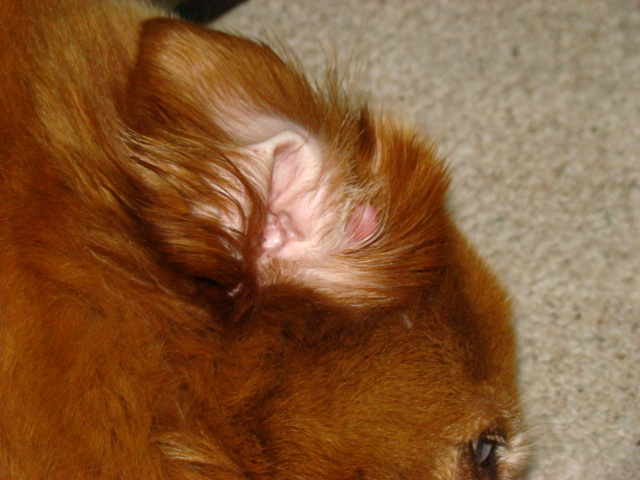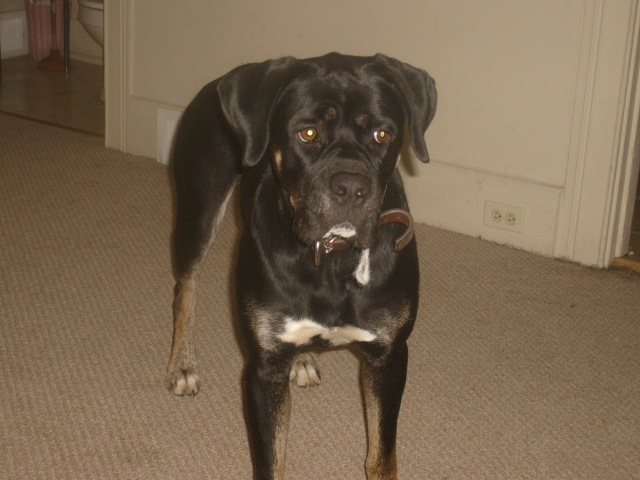QuestionWe took in a 1 1/2 year old beagle. We already have a 10 year old beagle we have had since birth. The rescued beagle when put in the fenced back yard (with or without the other beagle) will consistently sniff the ground the dog house barking as he goes. This behavior could last for hours. We tried a bark collar but he barked right thru the jolt. He does play with the older dog in a friendly way. We took him to obedience classes and he did ok, but was so excitable. He pulls when on a leash even with spikes in his neck. When brought in the house with the other dog he wants to zoom all around until he jumps into his bed with his blanket. But he can't be trusted to stay there for very long. His is good in his crate after we got him over his growling issue. He will be quiet all night inside his crate. Most of the day his in an outside large kennel and is doing better about not barking so much at everything he sees. We are weary, my son has now moved into an apartment and of coarse can't take Buster with him.(Oh, did I mention getting this dog was my sons idea and against my better judgement, but my son didn't want to see this dog go back to the SPCA when his friend couldn't handle Buster any longer-she had him since he was 6 months old he came from the SPCA. They paid to have this year old dog neutered) I love beagles and would like to try to keep him- he is soooo darn cute, but I'm very frustrated. Would prozac(or something like that) calm him down some? He is rubbing his nose sore! My neighbors have not complained yet, but his barking is very annoying. Do you have any advise? If he goes back to SPCA he might be put down because he had some bitting issues with the previous owners just some nipping with us, my son took care of that problem. Thank you for reading all of this, and would be grateful for any suggestions.
AnswerHi Lois,
You have the "typical" beagle problem. Beagles are prone to excessive barking. This may indeed have been why he was available for adoption! Some Beagles just enjoy the sensation and noise of barking. They're famous for it. Though your older dog may not bark as much, he was probably better socialized the than the dog you adopted.
Wile it's true that there are medications to help with behavioral issues (such as Prozac), medication has to go hand in hand with training, otherwise it won't be effective.
The running with with nose to the ground and barking the whole time (and never tiring!) is another Beagle trait. They were bred to be tracking dogs, this behavior is natural and you may never stop it.
Increasing the amount of daily exercise your dog gets can help. This has to be done in the way of brisk leashed walks, or a good run in the park (in a fenced area), or running after a ball. A tired dog is a quiet dog, but because he's still young it's going to take more time to tire him out. By the time this dog is 2 or 3 years old, you should see a reduction in his activity level.
Continue with the obedience classes can help. You said he did okay, and he'd continue to improve the more of it he gets. It's good mental stimulation for a dog, as well as learning important commands, such as quiet.
Interrupt the barking with a squirt of water from a spray bottle or water pistol. Alternately, a loud abrupt noise, like shaking an empty can that has several pennies in it can be used (tape over the open top!). Praise your dog the moment he's quiet, and tell him "Good Quiet". He may or may not go back to barking and if he does you do it again and again until he stops. Anytime your dog refrains from barking at a time when he normally would howl (a new sight, a new person, traveling in the car, etc) reward and praise him.
For a beagle who just likes the sound of his own voice, you can attempt to channel this vocal energy by teaching him to bark on command. This is a positive way of dealing with excessive noise, as it still gives him an outlet while earning praise from you at the same time. This is much more rewarding and realistic than trying to get him to stop at all costs.
Walking your dog with a shoulder harness can help control him better than a spiked collar. Also, there are "head harnesses" which are supposed to provide you with maximum control over the dog, and it won't hurt him as a spiked collar or choke chain can. Brands to look for are "Gentle Leader" and "Halti". You dog will need time to adjust to the unfamiliar feeling of a head harness. You need to ease him into accepting it with kindness and praise over a period of a few days. But once it's accepted you'd have a dog you can totally control on a leashed walk. Read about head harnesses here:
http://www.premier.com/View.aspx?page=dogs/products/behavior/gentleleader/descri...
http://www.youtube.com/watch?v=i6XMb2XRVVs
http://sub.allpetsconsidered.com/Primary%20Pages/Gentle_leader_instructions.htm
I hope I've been a help.
Best of luck,
Patti

 Cant afford medical care for my yorkie
Question
Mr. Bojangles BoBo
Hi, I adopted
Cant afford medical care for my yorkie
Question
Mr. Bojangles BoBo
Hi, I adopted
 Ear Care
Question
Erins Ear 2
I had my dog groomed two days ago
Ear Care
Question
Erins Ear 2
I had my dog groomed two days ago
 7 week old lurcher pup
Question
this is Lady
hi there me and my partner purch
7 week old lurcher pup
Question
this is Lady
hi there me and my partner purch
 Dog Worms
QuestionDog Poo
Dog Poo
QUESTION: Ive got
Dog Worms
QuestionDog Poo
Dog Poo
QUESTION: Ive got
 What is my dog
Question
This is the mystery do
a year ago a 11month ol
What is my dog
Question
This is the mystery do
a year ago a 11month ol